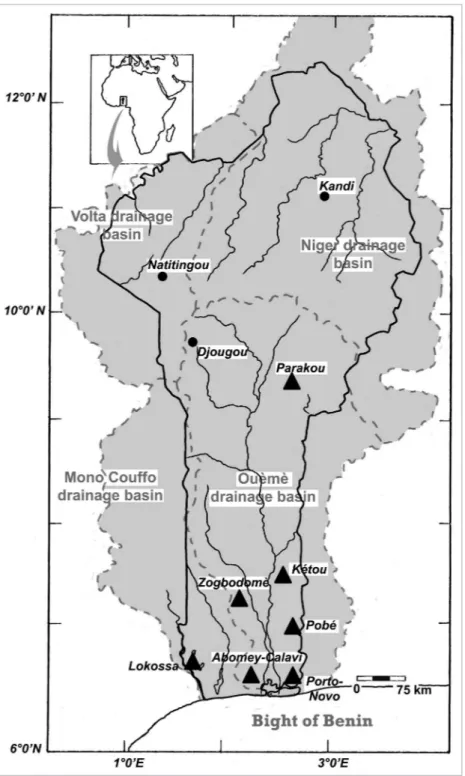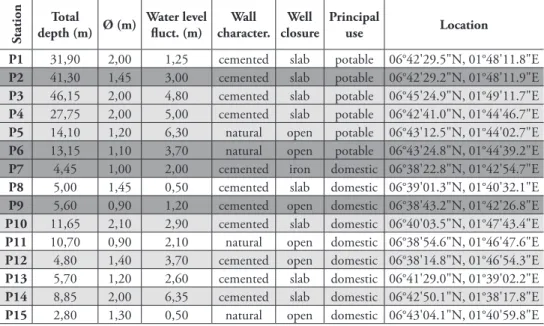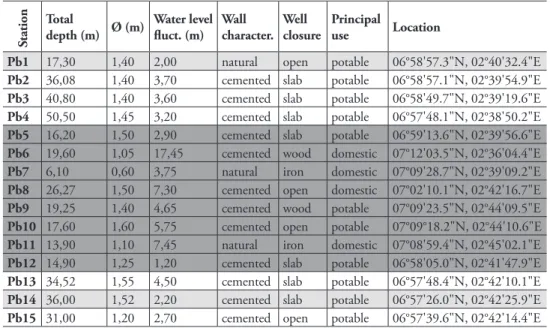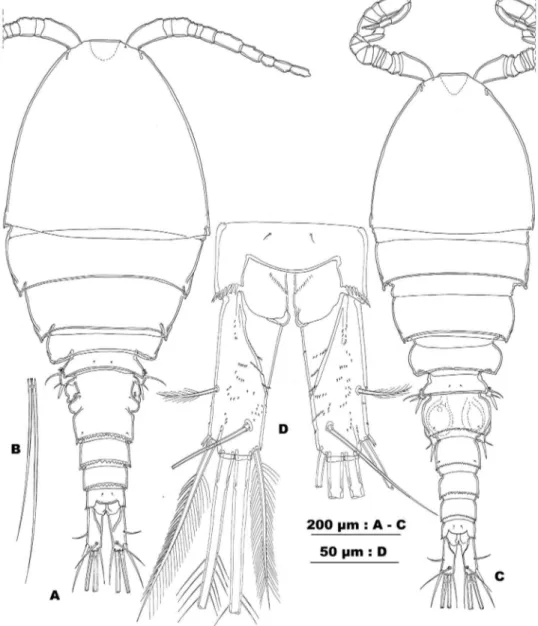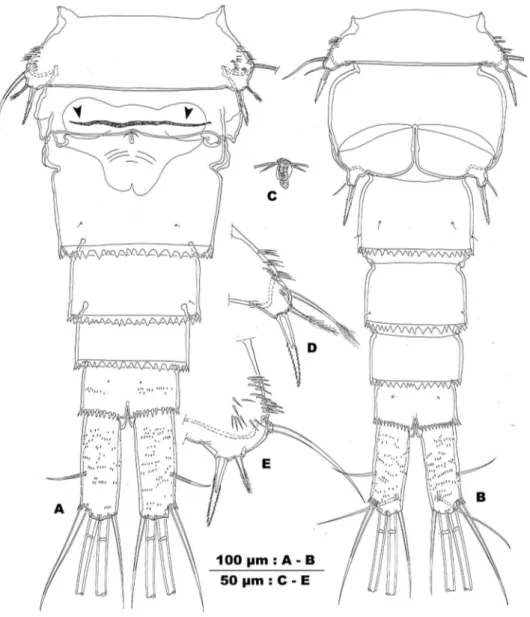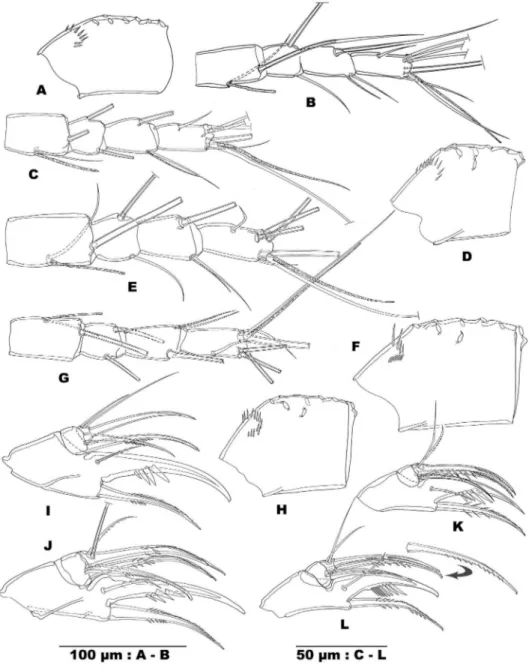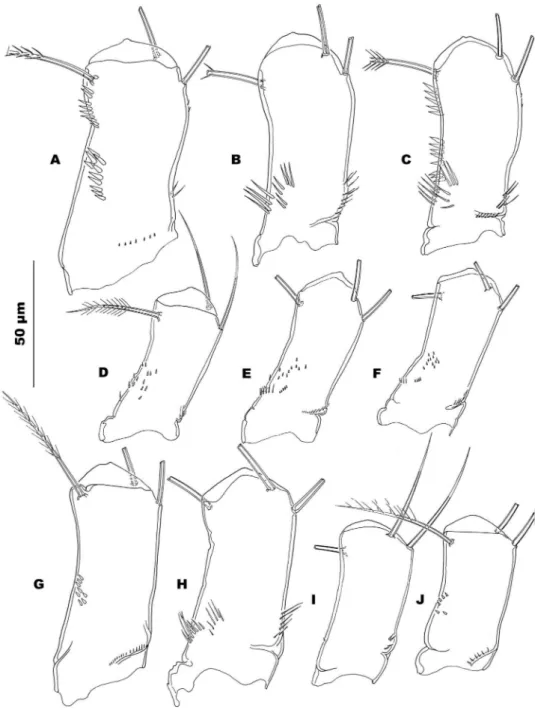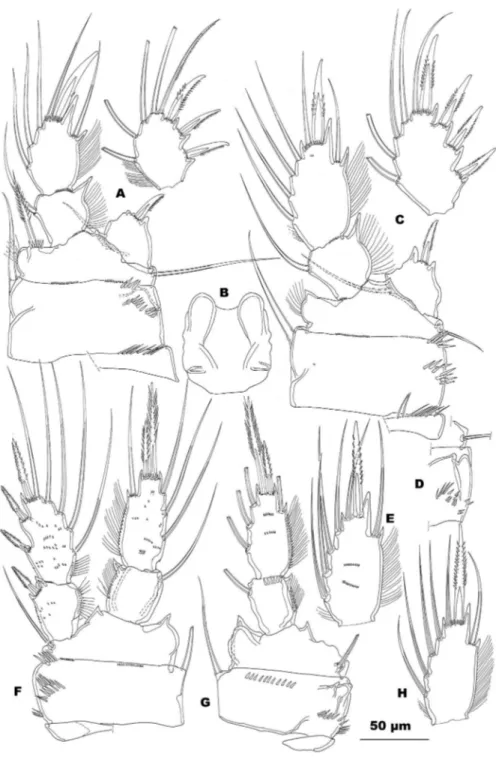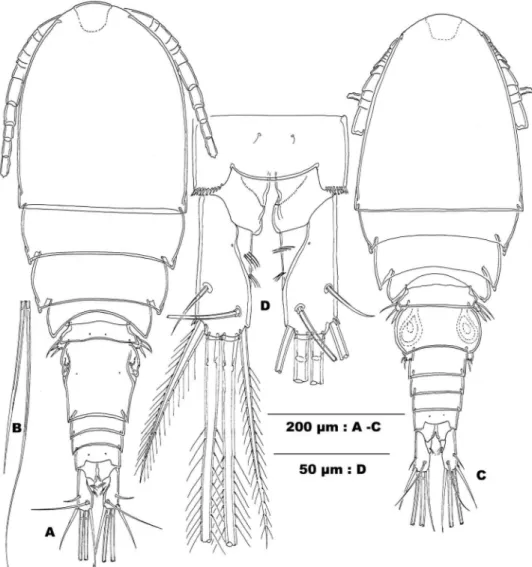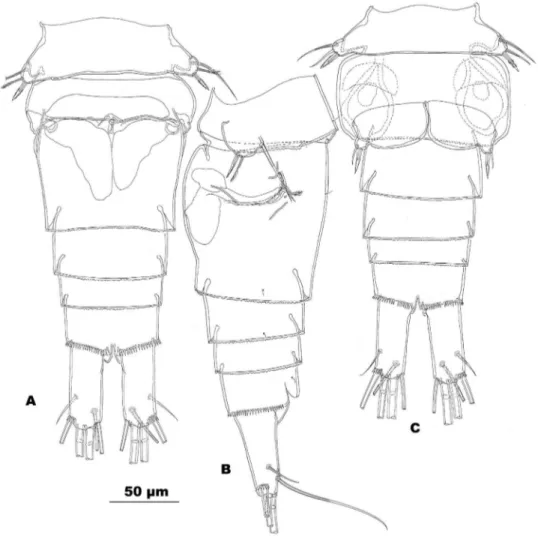Four new representatives of the genus Allocyclops Kiefer, 1932 from semi-consolidated... 1
Four new representatives of the genus
Allocyclops
Kiefer, 1932 from semi-consolidated subsoil aquifers
in Benin (Copepoda, Cyclopoida, Cyclopidae)
Frank Fiers1,2, Moïssou Lagnika3
1 Current address: Royal Belgian Institute of Natural Sciences, Vautierstraat 29, B-1000 Brussels, Belgium
2 “Emil Racoviţă” Institute of Speleology, Roman Academy, Clinicilor 5, PO Box 58, Cluj-Napoco, Romania
3 Département de Zoologie, Faculté des Sciences et Techniques, Université d’Abomey-Calavi, 01 BP: 526, République du Bénin
Corresponding author:Frank Fiers (frank.iers@naturalsciences.be)
Academic editor:Oana Moldovan | Received 6 January 2015 | Accepted 14 February 2015 | Published 24 June 2015
http://zoobank.org/C93851B1-7645-45D4-B9EB-F09586DD56F5
Citation: Fiers F, Lagnika M (2015) Four new representatives of the genus Allocyclops Kiefer, 1932 from semi-consolidated subsoil aquifers in Benin (Copepoda, Cyclopoida, Cyclopidae). Subterranean Biology 16: 1–36. doi: 10.3897/subtbiol.16.4467
Abstract
Several species of cyclopoid copepods were collected from improved and unimproved hang-dug-wells in the Republic of Bénin over the years 2009–2014. Fifty ive wells located in seven diferent districts were sampled: 15 wells in the district of Pobè (Department Plateau) and 1 well in Kétou (Department Plateau), 4 wells in Porto-Novo District (Department Ouémé) and, 15 wells in Lokossa District (Department Mono),18 wells in Parakou District (Department Borgou), 1 well in Abomey-Calavi District (Depart-ment Atlantique) and 1 in Zogbodomè District (Depart(Depart-ment Zou). Among them, 4 new species of the genus Allocyclops Kiefer, 1932 were found and are described herein: Allocyclops spinifersp. n., A. nudus
sp. n., A. pilosussp. n. and A.sakitiisp. n. hey are compared with the three African species previously
described. Allocyclops appears to be a sub-Saharan taxon specialized to thrive in the variable environment of subsoil aquifers in laterite deck beds. An identiication key to the 7 diferent African Allocyclops species is provided.
Keywords
Copepoda, Cyclopidae, subterraneous, Bénin, new species, key, laterites
Subterranean Biology 16: 1–36 (2015) doi: 10.3897/subtbiol.16.4467 http://subtbiol.pensoft.net
Copyright Frank Fiers, Moïssou Lagnika. This is an open access article distributed under the terms of the Creative Commons Attribution License (CC BY 4.0), which permits unrestricted use, distribution, and reproduction in any medium, provided the original author and source are credited.
RESEARCH ARTICLE
Subterranean
Introduction
Within the context of a research program in the Republic of Bénin on the biodiversity of the subterranean realm in relation to water quality, pollution vulnerably and local use 48 wells were regularly sampled over a period of one year. Seven wells located in the close vicinity of the monitored wells were occasionally visited. Six of the seven areas are located in the drainage basin of the Ouémé: the area of Parakou in the north of the basin and the area of Kétou, Zogbodomè, Pobè, Abomey-Calavi and Porto-Novo in the south. he seventh study area, the district of Lokossa, belongs to the lower part of the Mono-Coufo drainage basin (see Fig 1). Physico-chemical characteristics of the Pobè and Parakou wells have been published (Lagnika et al. 2014a; 2014b). Analyses of the other regions are currently under study.
he Republic of Bénin, a country 650 km long and 325 km at its widest, in South-West Africa is a sub-Saharan savannah region enduring a tropical climatologic regime: humid in the south, semi-arid in the north (Kottek et al. 2006; Peel et al. 2007). he principal rainy season spans from April to late July. A less intense rainy period is active in the southern part of the country from late September to November. he dry seasons are from December to April and from late July to early September. Wells, dug in the thick laterite deck beds, are of vital importance for the communities during the eight months of drought. hey also provide possibilities to study various aspects of this subterranean habi-tat and the local human impact on this extreme variable environment (Bonsor et al. 2013). African continental waters have been a very attractive study subject in zooplankton research. Large regions, however, of this vast continent remain unexplored (Dussart 1980). his is particularly true in regards of the fauna thriving in subsoil aquifers for which certain taxonomic groups are ignored because of inadequate sampling and, mainly, the lack of specialists (Boutin et al. 2011; Tuekam Kayo et al. 2012).
Among the copepods collected during this intensive study (i.e. mostly representa-tives of Afrocyclops Sars, 1927, hermocyclops Kiefer, 1927, Mesocyclops Sars, 1914) no less than four diferent species which undoubtedly belong to the cyclopid genus Allocy-clops were detected. hey are described herein and compared with the 3 other African
Allocyclops previously known.
Material and methods
Four new representatives of the genus Allocyclops Kiefer, 1932 from semi-consolidated... 3
Table 1. Sample localities and principal well characteristics in the district of Lokossa: presence of Allocy-clops species (dark grey background), other copepods (light grey background) and absence of Cyclopoida (white background).
Station
Total
depth (m) Ø (m)
Water level luct. (m) Wall character. Well closure Principal use Location
P1 31,90 2,00 1,25 cemented slab potable 06°42'29.5"N, 01°48'11.8"E
P2 41,30 1,45 3,00 cemented slab potable 06°42'29.2"N, 01°48'11.9"E
P3 46,15 2,00 4,80 cemented slab potable 06°45'24.9"N, 01°49'11.7"E
P4 27,75 2,00 5,00 cemented slab potable 06°42'41.0"N, 01°44'46.7"E
P5 14,10 1,20 6,30 natural open potable 06°43'12.5"N, 01°44'02.7"E
P6 13,15 1,10 3,70 natural open potable 06°43'24.8"N, 01°44'39.2"E
P7 4,45 1,00 2,00 cemented iron domestic 06°38'22.8"N, 01°42'54.7"E
P8 5,00 1,45 0,50 cemented slab domestic 06°39'01.3"N, 01°40'32.1"E
P9 5,60 0,90 1,20 cemented open domestic 06°38'43.2"N, 01°42'26.8"E
P10 11,65 2,10 2,90 cemented slab domestic 06°40'03.5"N, 01°47'43.4"E
P11 10,70 0,90 2,10 natural open domestic 06°38'54.6"N, 01°46'47.6"E
P12 4,80 1,40 3,70 cemented open domestic 06°38'14.8"N, 01°46'54.3"E
P13 5,70 1,20 2,60 cemented slab domestic 06°41'29.0"N, 01°39'02.2"E
P14 8,85 2,00 6,35 cemented slab domestic 06°42'50.1"N, 01°38'17.8"E
P15 2,80 1,30 0,50 natural open domestic 06°43'04.1"N, 01°40'59.8"E
Table 2. Sample localities and principal well characteristics in the district of Parakou: presence of Allocy-clops species (dark grey background), other copepods (light grey background) and absence of Cyclopoida (white background).
Station
Total
depth (m) Ø (m)
Water level luct. (m) Wall character. Closure Principal use Location
A1 7,78 1,2 1,18 cemented iron potable 09°16'22.7"N, 02°34'54.7"E
A2 6,95 1,05 0,85 cemented open domestic 09°19'40.3"N, 02°37'28.8"E
A3 5,9 1,25 1,15 natural iron domestic 09°20'53.9"N, 02°36'44.0"E
A4 13,15 1,5 4,35 cemented iron potable 09°18'42.1"N, 02°36'07.6"E
A5 8,4 1,2 3,1 natural open domestic 09°20'51.8"N, 02°36'14.8"E
A6 8,85 1,2 0,2 cemented open domestic 09°20'18.7"N, 02°37'36.3"E
B1 7,9 0,9 3,5 cemented iron potable 09°19'57.2"N, 02°39'40.6"E
B2 6,6 1,45 0,8 cemented iron potable 09°19'55.2"N, 02°39'40.5"E
B3 7,5 1,4 1,6 natural slab domestic 09°20'03.5"N, 02°37'47.2"E
B4 8,0 1,2 3,1 cemented open domestic 09°20'08.1"N, 02°37'45.4"E
B5 10,45 1,15 5,95 natural open domestic 09°20'18.0"N, 02°37'51.1"E
B6 16,15 1,4 10,55 cemented iron gardening 09°21'33.4"N, 02°38'32.4"E
C1 8,8 1,1 2,1 cemented iron domestic 09°23'28.7"N, 02°37'21.4"E
C2 14,2 1,8 5,5 cemented iron potable 09°23'05.5"N, 02°37'23.2"E
C3 10,8 1,2 5,8 cemented iron potable 09°21'58.4"N, 02°37'30.6"E
C4 5,5 1 0,9 natural open domestic 09°21'45.4"N, 02°37'46.6"E
C5 12,85 2 7,25 cemented iron potable 09°21'56.9"N, 02°36.41.2"E
Four new representatives of the genus Allocyclops Kiefer, 1932 from semi-consolidated... 5
Table 4. Sample localities and principal well characteristics in the district of Porto-Novo: presence of
Allocyclops species (dark grey background).
Station
Total
depth (m) Ø (m)
Water level luct. (m) Wall character. Closure Principal use Location
AR 7,80 0,90 3,00 cemented iron domestic 06°29'04.2"N, 02°38'24.3"E
SA 7,00 0,90 2,00 natural open domestic 06°29'02.4"N, 02°38'26.0"E
LB 10,50 0,85 2,85 natural open domestic 06°29'05.7"N, 02°38'25.3"E
AH 4,00 1,00 2,50 natural iron domestic 06°29'18.8"N, 02°38'14.8"E
Table 3. Sample localities and principal well characteristics in the district of Pobè: presence of Allocy-clops species (dark grey background), other copepods (light grey background) and absence of Cyclopoida (white background).
Station
Total
depth (m) Ø (m)
Water level luct. (m) Wall character. Well closure Principal use Location
Pb1 17,30 1,40 2,00 natural open potable 06°58'57.3"N, 02°40'32.4"E
Pb2 36,08 1,40 3,70 cemented slab potable 06°58'57.1"N, 02°39'54.9"E
Pb3 40,80 1,40 3,60 cemented slab potable 06°58'49.7"N, 02°39'19.6"E
Pb4 50,50 1,45 3,20 cemented slab potable 06°57'48.1"N, 02°38'50.2"E
Pb5 16,20 1,50 2,90 cemented slab potable 06°59'13.6"N, 02°39'56.6"E
Pb6 19,60 1,05 17,45 cemented wood domestic 07°12'03.5"N, 02°36'04.4"E
Pb7 6,10 0,60 3,75 natural iron domestic 07°09'28.7"N, 02°39'09.2"E
Pb8 26,27 1,50 7,30 cemented open domestic 07°02'10.1"N, 02°42'16.7"E
Pb9 19,25 1,40 4,65 cemented wood potable 07°09'23.5"N, 02°44'09.5"E
Pb10 17,60 1,60 5,75 cemented open potable 07°09°18.2"N, 02°44'10.6"E
Pb11 13,90 1,10 7,45 natural iron domestic 07°08'59.4"N, 02°45'02.1"E
Pb12 14,90 1,25 1,20 cemented slab potable 06°58'05.0"N, 02°41'47.9"E
Pb13 34,52 1,55 4,50 cemented slab potable 06°57'48.4"N, 02°42'10.1"E
Pb14 36,00 1,52 2,20 cemented slab potable 06°57'26.0"N, 02°42'25.9"E
Pb15 31,00 1,20 2,70 cemented open potable 06°57'39.6"N, 02°42'14.4"E
water, “domestic” when the water is used for all purposes, and “gardening” when used only for private household gardens. Sample dates are provided with the description of each spe-cies. Detailed information on the diferent drainage basins was extracted from the reports made available through the “Direction Générale de l’Eau” (2008).
Biological samples of the water column were taken with a Cvetkov plankton net (funnel 200 µm mesh size, 150 µm below valve). Baited traps were used to collect bottom dwelling animals. Total depth, diameter (Ø), and mean water depth were measured with a decametre and the exact location with a Garmin® GPS60. Samples were ixed at the spot adding 100 ml of a 7% formaldehyde solution. Sorted out at the laboratory of the Zoology Department of the Abomey-Calavi University, each taxon has been stored separately and preserved in 70% ethanol.
Copepods were irst observed in temporary slides (mounted in glycerol). Dissect-ed animal parts are mountDissect-ed on permanent slides in glycerol, the cover glasses sealDissect-ed with a polyurethane varnish. Preserved specimens are stored in 75% bufered ethyl alcohol (with 5–10% glycerol). All material is stored in the Crustacea collection of the Royal Belgian Institute of Natural Sciences and inventoried with acc. nr RBINSc COP #. Observations and illustrations were made on a Leitz Diaplan phase contrast microscope equipped with a camera lucida. Abbreviations used in the descriptions: Aesth, aesthetasc; CIV-CV, copepodid stages 4 and 5; EXO, END, exopodite and endopodite, respectively; L/W ratio, length/width ratio; armature distribution of the leg ramal segments: Roman numerals refer to spines, Greek numerals to setae.
Taxonomy
Family Cyclopidae Rainesque, 1815
Genus Allocyclops Kiefer, 1932 amend. Fiers, 2012
Allocyclops spinifer sp. n.
http://zoobank.org/FE0625DC-8A08-45A3-AC41-44566A1C2426
Figs 2, 3, 4A, B, I, 5A–C, 6
Type locality. Ishèko (Pobè District, Ouémé drainage basin), Well Pb5: West from Pobè center along the principal road to Kétou District (details in Table 3).
Type material. Female holotype, dissected and mounted on 3 slides (RBINSc COP 10.304A-C), allotype male, dissected and mounted on 3 slides (RBINSc COP 10.305A-C), 1 female paratype dissected on 2 slides (RBINSc COP 10.306A-B) and 4 females, 5 males and 4 juveniles preserved (RBINSc COP 10.307), all collected 26/07/2012; additional paratypic material: 3 females, 4 males, 5 juveniles (preserved material RBINSc COP 10.353), topotypic, collected 16/04/2013.
Etymology. derived from the Latin words spinula and ferre, respectively meaning small thorn and to carry, and referring to the spinular ornamentation on pediger 5, on leg 4 and on the caudal rami.
Additional material.
(1) Pobè District, Ouémé drainage basin:
Four new representatives of the genus Allocyclops Kiefer, 1932 from semi-consolidated... 7
Figure 2.Allocyclops spinifer sp. n. A habitus in dorsal view B principal setae of left caudal ramus C habitus in dorsal view D anal somite and caudal rami, dorsal view. (Female RBINSc COP 10.304: A,B,D; male RBINSc COP 10.305: C).
– Well Pb12: 24/07/2012: 3 ♀♀, damaged (preserved material RBINSc COP 10.328).
(2) Zogbodomè District, Ouémé drainage basin:
– Well Zogbodomè: 21/10/2009: 2 ♀♀, 1 ♂ (preserved material RBINSc COP 10.387).
Description. Female. Habitus (Fig. 2A) typically cyclopid with prominent pro-some, 1.6 times longer than urosome. Body length 1175 µm (holotype), ranging from 1075 to 1200 µm (n=5). Urosome rather narrow, compared to wide cephalothorax and pediger 2. Urosomite 1 (pediger 5) with cluster of long and rigid spinules on the lateral and ventrolateral surface (Fig. 3D). Genital double-somite widest in anterior third, with distinct constriction of lateral margins in anterior half and a L/W ratio: 1/1.25. Ventral surface with, in frontal third, a transverse undulate ridge parallel with lateral arms of genital complex (dotted line between arrows in Fig. 3A) and, caudally from copulatory pore, some crescent ridges. Posterodorsal fringe of prosomites 1–3 narrow and un-incised, of prosomite 4 and irst urosomite narrow and discretely ser-rate. Posterior margin of genital double-somite and urosomites 4–5 wide and serrate, coarsely incised. Anal somite with smooth crescent operculum and large anal sinus. he latter with an oblique row of minute and slender spinules on either side of the anal slit. Posterior margin of anal somite with uninterrupted row of spinules. Dorsal and lateral surface of urosomites adorned with minute, hardly visible spinules. Ventral surface of anal somite with an irregular pattern of slightly larger spinules.
Caudal rami (Fig. 2D) cylindrical, 2.7–3.0 times longer than wide, with distinct triangular depression in anterior half of medial margin. Anterolateral seta short, pin-nate, and inserted in posterior half, without spinules at insertion. Distolateral element slightly longer than ramus (ratio 1.2–1.3/1) and longer than medial terminal element (ratio 1.2–1.4/1). Distolateral element with widely spaced long and slender spinules along outer side of stem, with widely spaced setules along inner side; spinules present near its insertion. Medial element as long as caudal ramus, and pinnate. Dorsal seta, articulating on small basal part, shorter than ramus (ratio 0.8–0.9/1). Principal ter-minal caudal setae pinnate, with breaking plane present in both. Surface of rami with irregular and defuse pattern of minute spinules on dorsal and ventral side, triangular anteromedial depression clearly delimited dorsally.
Antennule 11-segmented, not reaching beyond cephalothorax, and having the typical armature distribution i.e.: 1(8)-2(4)-3(6)-4(2)-5(2)-6(2)-7(3)-8(2+Aesth.)-9(2)-10(2+Aesth.)-11(7+Aesth). First segment with crescent row of slender spinules in proximal half (Fig. 4A). Aesthetasc on segment 8 half as long as accompanying seta, linguiform, and reaching just beyond distal margin of segment 8. Aesthetasc on segment 10 iliform, shorter than accompanying element and extending to middle of terminal antennulary segment. Terminal aesthetasc tubular, slightly longer than seg-ments 10–11 combined, and fused at base with seta; both equally long (Fig. 4B).
Four new representatives of the genus Allocyclops Kiefer, 1932 from semi-consolidated... 9
Figure 3.Allocyclops spinifer sp. n. A urosome in ventral view B urosome in ventral view C copulatory pore and duct D leg 5 and lateral part of pediger, in ventral view E leg 5 and lateral side of pediger in ventral view. (Female RBINSc COP 10.304: A,C; RBINSc COP 10.306: E; male RBINSc COP 10.305: B,D).
rows of coarse spinules parallel to outer margin (proximal one with 10–12, distal one with 9–10 spinules) and short proximal transverse row of tiny spinules near abexopo-dal margin. Cauabexopo-dal surface (Fig. 5B, C) with 3 clusters of long and slender spinules in proximal half: 2 clusters near outer margin, 1 near inner margin.
sides in proximal half, on one side in distal half. Both elements on irst endopodite segment with set of large spinules in middle. Distal half either smooth or with minute spinules along both sides of the stem. Terminal element on second endopodite seg-ment articulating on segseg-ment, furnished with minute spinules along one side of the stem. Both lateral elements on second segment slender and naked.
Legs 1–4 protopodite (Fig. 6A, C, D, F, G). Praecoxa of legs 1–3 with short row of slender spinules along distal margin close to outer edge. Praecoxa of leg 4 smooth. Outer part of coxa with 2 (legs 1–3) or 3 (leg 4) short rows of spinules on frontal surface. Coxal caudal surface of legs 1–3 with set of spinules near proximal outer edge (see ex. for leg 2: Fig. 6D). Medial coxal seta of legs 1–4 pinnate and reaching beyond proximal endopodite segment. Intercoxal sclerites unadorned on both sides. Lateral distal edges crescent without ornamentation. Mediodistal region concave (legs1–3: Fig. 6B) or nearly straight (leg 4). Inner edge of leg 1 basis crescent, of legs 2–4 pro-duced in sharp triangular process. Medial margin hairy in legs 1–3, naked in leg 4. Inner element on leg 1 basis present, serrate and reaching beyond proximal endopodite segment, but not beyond middle of distal segment. Outer element on basis of the legs setiform: longest on leg 1 basis, shortest one on basis of leg 2.
Legs 1–4 with 2-segmented rami (Fig. 6A, C, F, G). Exopodite and endopodite equally long. Rami with the following armament distribution:
EXO END
Leg 1 I,1 - III,2,3 0,1 - 1,I+1,3 Leg 2 I,1 - III,I+1,4 0,1 - 1,I+1,4 Leg 3 I,1 - III,I+1,4 0,1 - 1,I+1,4 Leg 4 I,0 - II,I+1,4 0,1 - 1,II,3
Outer distal edge of second endopodite segment of legs 1–3 distinctly protruded, of leg 4 small and as large as inner one. Frontal and caudal surface of leg segments of legs 1–2 and frontal surface of leg 3 unadorned. Caudal surface of distal endopodite segment of leg 3, and frontal and caudal surface of leg 4 segments with difuse pattern of tiny spinules.
Caudal surface of proximal endopodite segment of leg 4 inlated. Distal endo-podite segment of leg 4 twice as long as wide with inner terminal spine as long as segment. Outer terminal spine slightly longer than half inner one (ratio: 0.55–0.56). Inner terminal spine set with long slender spinules. Outer subdistal and inner setae, equally long, not reaching noticeably beyond longest (outer) terminal spine.
Leg 5 (Fig. 3E) conluent with pediger, represented by narrow crescent expansion. Ancestral basal segment represented by long pinnate element, and ancestral distal seg-ment marked by narrow truncate elevation, bearing 2 eleseg-ments: setiform outer one, spiniform medial one, the latter twice as long as the former.
Four new representatives of the genus Allocyclops Kiefer, 1932 from semi-consolidated... 11
Figure 4.Allocyclops spinifer sp. n. A antennulary segment 1 B antennulary segments 8–11; A. pilosus
sp. n. C antennulary segments 8–11 D antennulary segment 1; A. nudus sp. n. E antennulary segments 8–11 F antennulary segment 1; A. sakitii sp. n. G antennulary segments 8–11 H antennulary segment 1;
A. spinifer sp. n. I maxillary basis and endpodite; A.nudus sp. n. J maxillary basis and endopodite; A.pilosus
bilobed. Lateral arms (= narrow canal-like rim extending from copulatory duct to geni-tal aperture) straight.
Male. Habitus (Fig. 2C) as in female, but with narrower prosome and 6-segmented urosome. Body length: 1000 µm (allotype), ranging from 807–1000 µm (n=5). Integu-mental ornamentation, fringe structure and L/W ratio of caudal rami as in the female (2.7–3.0/1). Armature: distolateral element 1.27–1.30 times longer than ramus, ter-minal medial element nearly 0.9–1.0 times ramal length, dorsal seta as long as ramus.
Antennule as described for A. cavicola: i.e.16-segmented with the following ar-mature distribution: 1(8+3 Aesth.)-2(4)-3(2)-4(1)-5(2)-6(2)-7(2)-8(2)-9(2+Aesth.)-10(2)-11(2)-12(2)-13(1+Aesth.)-14(4)-15(3)-16(11+Aesth.). Aesthetascs on segment 1, 9 and 13 long, narrow and linguiform. Mouthparts as in the female. Legs 1–4 with general structure and armature as in the female, but terminal segment of endopodites slightly narrower (see ex. for leg 3: Fig. 6H) and leg 4 proximal endopodite segment not expanded caudally.
Leg 5 (Fig. 3D) with expansion representing distal segment more accentuated than in female. Proportional lengths of armament as in the female. Spinule ornamentation on lateral and ventral surface of pediger less dense than in the female.
Leg 6 (Fig. 3B) represented as a large, unadorned, valve with outer distal edge distinctly produced bearing 2 elements: outer one setiform, half as long as medial spiniform element.
Variability. Animals from Well Pb 6 collected on 07/02/2011 are smaller with the body length of the females ranging from 875 to 1009 µm, that of the males between 890–895 µm. hey display shorter caudal rami (L/W ratio 1/2.6–2.7) with slightly longer setae: distolateral one 1.3–1.4 times longer than the ramus, and medial terminal element 1.1–1.3 times longer than ramus. In all other respects they resemble A. spinifer
sp. n. as described above.
Allocyclops pilosus sp. n.
http://zoobank.org/FA418D62-E64F-417A-A11E-8B5D3B147922
Figs 4C, D, K, 5D–F, 7, 8, 9
Syn. Allocyclops sp. [partim] in Lagnika et al. 2014b
Type locality. Guéma, Parakou District, Ouémé drainage basin: Well C2 (details in Table 2).
Four new representatives of the genus Allocyclops Kiefer, 1932 from semi-consolidated... 13
Figure 5. Antennary coxobasis: Allocyclops spinifer sp. n. A frontal view B caudal view C caudal view;
Etymology. From the Latin word “pilus” meaning hair and refers to the rows of delicate hairs along the medial margin of the caudal rami.
Additional material.
(1) Parakou District, Ouémé drainage basin:
– Well A1: 10/07/12: 5 ♀♀, 1 CV juvenile ♀ (preserved material RBINSc COP 10.321);
– Well B6: 26-10-11: 1 ♀ (preserved material RBINSc COP 10.320); RBINSc COP 10.311);
– Well C6: 13/12/10: 11 ♀♀ (dissected ♀ RBINSc COP 10.316A-B, preserved material RBINSc COP 10.317; 29/10/2011: 33 ♀♀, 1 juvenile (preserved material RBINSc COP 10.342).
(2) Pobè, Plateau District, Ouémé drainage basin:
– Well Pb6: 07/02/11: 4 ♀♀ (preserved material RBINSc COP 10.332); 27/07/2012: 4 ♀♀, 2♂♂ (♀ dissected RBINSc COP 10.385A-B, preserved material RBINSc COP 10.336); 26/11/12 : 2 ♀♀ (preserved material RBIN-Sc COP 10.374); 04/03/2013: 3 ♀♀, 3♂♂, 2 juveniles (preserved material RBINSc COP 10.345); 20/09/2013: 5 ♀♀, 1 CV copepodite (preserved ma-terial RBINSc COP 10.375);
– Well Pb7: 27/7/12: 15 ♀♀, 4 ♂♂ (dissected ♀ RBINSc COP 10.325A-B, preserved material RBINSc COP 10.326); 16/04/2013: 28 ♀♀, 2 ♂♂, 1 ju-venile (preserved material RBINSc COP 10.346);
– Well Pb 8: July 2013: 2 juveniles (preserved material RBINSc COP 10.343); – Well Pb 9: 17/04/2013: 2 ♀♀ (preserved material RBINSc COP 10.341); – Well Pb10: 27/07/2012: 2 ♀♀ (preserved material RBINSc COP 10.347);
30/09/2012: 2 ♀♀, 2 ♂♂ (preserved material RBINSc COP 10.384); 25/11/2012: 3 ♀♀ (preserved material RBINSc COP 10.383);
– Well Pb11: 27/07/2012: 68 ♀♀, 3 ♂♂ (preserved material RBINSc COP 10.344); 30/09/2012: 387 F 5 CV females; 23/02/13: 3 ♀♀, 6 CIV juvenile ♀♀, 4 CV juvenile ♀♀ (dissected adult ♀♀ RBINSc COP 10.322A-C and COP 10.323A-C, preserved material RBINSc COP 10.324);
(3) Porto-Novo, Ouémé District, Ouémé drainage basin:
– Well SA: 01/01/10: 8♀♀, 1 CIV ♀ juvenile (dissected ♀ RBINSc COP 10.318A-B, preserved material RBINSc COP 10.319); 24/10/2010: 625 adult females and males (preserved material RBINSc COP 10.382);
– Well AH: 01/11/2009: 12 ♀♀ with body covered with stalked ectoparasites (preserved material RBINSc COP 10.329 and COP 10.330); 30/03/2013: 1 ♀ (preserved material, RBINSc COP 10.380); 31/01/2014: 6 ♀♀ 2 CV juve-niles (preserved material, RBINSc COP 10.381);
– Well AR: 09/12/2010: 1 ♀ (material preserved RBINSc COP 10.331); June 2013: 1 ♀, damaged (preserved RBINSc COP 10.379);
Four new representatives of the genus Allocyclops Kiefer, 1932 from semi-consolidated... 15
Figure 6.Allocyclops spinifer sp. n. A leg 1, frontal view B intercoxal sclerite of leg 1, frontal view C leg 2, frontal view D outer region of coxa and basis of leg2, caudal view E distal segment of leg 3 endopodite, caudal view F leg 4, frontal view G leg 4 protopodite and endopodite, caudal view H distal endopodite segment of leg 3, frontal view. (Female RBINSc COP 10.306: A,B,C,G; female RBINSc COP 10.304:
(4) Kéwi, Kétou District, Ouémé drainage basin:
– village well: 08/02/11: 17 ♀♀, 1 ♂ (preserved material RBINSc COP 10.315).
Description. Female. Body (Fig. 7A) typically cyclopid with prosome and uro-some almost equally long. Prouro-some less prominent than in preceding species. Body length: 745 µm (730–820 µm, n=5). Laterocaudal expansion of urosomite 1 (pediger 5) accentuated by outwards directed leg 5 (Fig. 8A). Genital double-somite widest in anterior third, tapering caudally. Length/width ratio 1/1. Urosomites 4–5 parallel sided. Cephalothorax, metasomites and irst urosomite with narrow and straight pos-terior fringe. Pospos-terior fringe of genital double somite and urosomites 4–5 narrow and delicately serrate. Surface of somites smooth. Anal somite (Fig. 7D) with continuous row of spinules along posterior margin. Anal operculum crescent, not expanded. Anal sinus with single oblique row of minute spines on both sides.
Caudal rami (Fig. 7D) cylindrical with large mediodorsal triangular depression and 2.7 times as long as wide. Lateral anterior seta short, inserted at caudal end of median third. Distolateral element longer than ramus (ratio: 1/1.2–1.3), furnished with long slender and widely spaced spinules along outer side of stem, and widely spaced setules along medial side. Medial terminal element longer than distolateral one (ratio: 1/0.75) and ramus (ratio: 1/0.65). Breaking plane in both principal terminal setae present; each seta pinnate. Dorsal seta located in caudal third, near medial edge, articulating on short basal part and as long as medial terminal seta. Medial depression with two series of slim spinules (hairlike) arranged perpendicularly on principal axis of the rami. Posterolateral element with spinules at insertion, anterolateral one without.
Antennule 11-segmented with typical armature distribution. First segment with crescent row of slender spinules in proximal half (Fig. 4D). Aesthetasc on segment 8 as long as accompanying seta, linguiform, and reaching almost to distal margin of seg-ment 9. Aesthetasc on segseg-ment 10 iliform, shorter than accompanying eleseg-ment and reaching beyond middle of terminal antennulary segment. Terminal aesthetasc as long as segments 9–11 combined, fused at base with seta. he latter longer than aesthetasc (Fig. 4C).
Antennal general aspect and armature as in A. cavicola. Frontal surface of coxobasis with defuse pattern of minute spinules in proximal half on and near outer margin (Fig. 5D). Caudal surface with 3 short rows of tiny spinules in proximal half: 1 near outer margin, 1 below a difuse distal cluster of tiny spinules, and 1 near inner margin (Fig. 5E, F).
Mandible, maxillule and maxilliped as in A. cavicola. General aspect of maxilla as in A. cavicola. Medial claw of basis rather short and sharp, furnished with 4 large teeth increasing in length medially (Fig. 4K). Accessory element as long as claw, fur-nished with widely spaced spinules in proximal half, densely serrate in distal half. First endopodite segment with one smooth and one serrate element. Terminal element on second endopodite segment conluent with segment, with long widely spaced spinules in proximal half and densely serrate in distal half.
min-Four new representatives of the genus Allocyclops Kiefer, 1932 from semi-consolidated... 17
Figure 7.Allocyclops pilosus sp. n. A habitus in dorsal view B principal caudal setae of left caudal ramus
C habitus in dorsal view D anal somite and caudal rami in dorsal view (Female RBINSc COP 10.310:
A, B,D; male RBINSc COP 10.312: C).
to upper quarter of distal endopodite segment. Medial margin of leg 1 basis crescent and hairy. Outer seta of leg 1 basis longer than exopodite. Medial margin of legs 2–3 basis hairy, naked in leg 4. Distal inner edge of basis of legs 2–4 with short triangular expansion. Outer element on basis of leg 2 short, of legs 3–4 long.
Legs 1–4 with 2-segmented rami. Exopodite and endopodite of the legs equally long (Fig. 9A, C, F, G). Armament distribution and general aspect of segments as in preceding species. Segments devoid of ornamentation on frontal and caudal surface. Proximal endopodite segment of leg 4 lat, not expanded caudally. Leg 4 distal en-dopodite segment 2.2–2.3 times longer than wide with inner terminal spine slightly shorter than segmental length. Outer terminal spine half as long as inner one. Outer subdistal seta reaching to or just beyond tip of inner terminal spine, inner subdistal seta reaching far beyond tip of inner terminal spine. Proximal inner seta shorter than segment.
Leg 5 (Fig. 8A, B) conluent with pediger, represented as a single semi-circular ex-pansion. Ancestral basal segment obsolete, represented by long pinnate seta. Ancestral distal segment represented by two equally long elements: outer one setiform, inner one spiniform.
Leg 6 (Fig. 6B) positioned laterally. Valve surface unadorned and bearing three elements on outer caudal edge: outer one setiform, median and medial one minute and truncate. Genital complex with copulatory pore leading to U-shaped duct. Lateral arms straight. Anterior receptacle expanded, with straight frontal margin. Posterior receptacle bi-lobed, expanded far caudally.
Male. Prosome and urosome equally long with metasome narrower than in the female (Fig. 7C). Urosomite 2 or pediger 6 (Fig. 8C) wide and short (W/L ratio: 2/1). Posterodorsal fringe of prosomites and posterior fringe of urosomites as in the female. Caudal rami with medial hairy ornamentation and armament as in the female. Body length: 668 µm (allotype, paratypes 665–700 µm, n=5).
Antennule as described for A. cavicola in Fiers (2012) with 3 long linguiform aes-thetascs on segment 1. Antennary armament and spinule pattern, mouthparts and legs 1–4 as in the female.
Leg 5 (Fig. 8C) as in the female. Leg 6 (Fig. 7 C) represented by large semi-ovate unadorned valve. Outer caudal edge expanded, bearing two elements: outer one seti-form, medial one spiniform. he former shorter than the latter.
Four new representatives of the genus Allocyclops Kiefer, 1932 from semi-consolidated... 19
Figure 8.Allocyclops pilosus sp. n. A urosome in ventral view B urosome in lateral view C urosome in ventral view (Female RBINSc COP 10.310 A,B; male RBINSc COP 10.312: C).
Allocyclops nudus sp. n.
http://zoobank.org/9231A518-6786-4A71-ACFE-5AD9DE002D62
Figs 4E, F, J, 5G, H, 10, 11, 12
Syn. Allocyclops n sp. [partim] in Lagnika et al. 2014b
Type locality. Ladjifarani or “Nouveau quartier”, Parakou District, Ouémé drainage basin: Well B6 (details in Table 2).
addi-tional paratypic material (topotypes): 3 females collected 16/01/11 (preserved RBINSc COP 10.352).
Etymology. From the Latin adjective “nudus” meaning naked and refers to the absence of hairy or spinular ornamentation on the pedigers surface and caudal rami, contrasting the species from A. spinifer sp. n. and A. pilosa sp. n.
Additional material.
(1) Parakou District, Ouémé drainage basin.
– Well A1: 27/08/2011: 1 ♀, 8 ♂♂ (preserved material RBINSc COP 10.337); 11/01/2011: 4 ♀♀, 1 ♂, 40 juveniles, decomposed condition (preserved mate-rial RBINSc COP 10.348); 15/02/2011: 2 ♀♀, 3 ♂♂, 20 juveniles (preserved material RBINSc COP 10.351); 10/07/2012: 48 ♀♀, 12 ♂♂ (preserved ma-terial RBINSc COP 10.338);
– Well A5: 16/11/2010: 2♂♂, 4 juveniles (preserved material RBINSc COP 10.350); – Well C3: 30/10/2011: 1 ♂ (dissected male RBINSc COP 10.368); 14/02/2011:
27 ♀♀, 1 ♂ (preserved material RBINSc COP 10.349).
Description. Female: Body (Fig. 10A) typically cyclopid with prosome longer than urosome (ratio: 1/0.8). Principal body lexure well marked, rather wide. Geni-tal double-somite widest in anterior third, tapering caudally, and as long as widest part. Anal somite with crescent operculum, not expanded. Anal sinus unadorned. Length 900 µm (holotype, paratypes 890–962 µm, n=5). Posterodorsal margins of cephalothorax and pedigers 2–3 straight, of pediger 4 slightly irregular. Urosomite 1 with straight posterodorsal fringe. Posterior margin of genital double-somite and urosomites 4–5 wide, coarsely serrate. Posterior margin od anal somite with uninter-rupted row of spinules along ventral and dorsal margins.
Caudal rami cylindrical with triangular depression along anterior half of medial mar-gin, less than 3 times longer than wide (L/W-ratio 1/2.7–2.8). Anterolateral seta, pinnate, short, without spinules near articulation. Posterolateral element shorter than ramus in holotype (ratio: 0.9/1) ranging from 0.8/1–1.0/1 in paratypes), with long and slender spinules along outer side of the stem, pinnate along the inner side. Spinules present at it insertion with ramus. Medial element longer than ramus (ratio: 1.15–1.25/1) and pin-nate. Principal terminal setae with breaking plane and pinpin-nate. Dorsal seta 1.3–1.4 times longer than ramus, and articulating on small basal part. Integument of rami unadorned.
Antennule 11-segmented with typical armament, not reaching to posterolateral edge of cephalothorax. Segment 1 with set of slender spinules and set of short ones (Fig. 4 F). Aesthetasc on segment 8 linguiform, reaching beyond middle of segment 9. Aesthetasc on segment 10 iliform, shorter than accompanying seta and reaching halfway terminal segment. Aesthetasc on segment 11 tubular, as long as segments 9–11 combined, and shorter than accompanying seta (Fig. 4E).
Four new representatives of the genus Allocyclops Kiefer, 1932 from semi-consolidated... 21
Mouthparts as in preceding species. Maxillary basis (Fig. 4J) prominent and blunt, with set of 4–5 large spinules in middle, increasing in length medially. Accessorial seta robust, with large spinules on both sides of the stem in proximal half, inely serrate along one side in distal half. Armature of proximal endopodite segment and terminal armature element on distal endopodite segment robust, with large spinules in proximal half and inely serrate in distal half on one side of the stem. Terminal seta on distal endpodite segment conluent with segment. Additional elements on distal segment sparsely serrate.
Leg 1–4 protopodite (Fig. 12A–D). Frontal margin of praecoxa with short row of slender spinules near outer corner. Frontal surface of legs 1–4 coxa unadorned except for some minute spinules along distal margin. Caudal surface of leg 1 unadorned, of legs 2 and 3 with some slender spinules near outer proximal corner. Caudal surface of leg 4 coxa with a transverse row of spinules parallel to distal margin and some slender spinules near outer proximal corner. Intercoxal sclerite of legs 1–4 as in preceding species. Medial coxal seta present, pinnate and reaching beyond basis, attending distal margin of proximal endopodite segment in leg 1, and middle of proximal endopodite segment in legs 2 and 3. Medial element somewhat shorter in leg 4. Medial margin of basis of leg 1 crescent, hairy, and with pinnate element reaching beyond proximal endopodite segment. Spinules present at its insertion. Medial margin of basis of legs 2–4 crescent, produced distally in short triangular expansion. Hairy in legs 2–3, naked in leg 4. Outer seta on leg 1 basis as long as exopodite, and as long as irst exopodite segment in legs 2–4.
Leg 1–4 rami 2-segmented with general appearance and armament distribution as in preceding species. Frontal and caudal surface of ramal segments unadorned. Proxi-mal segment of leg 4 endopodite inlated caudally (Fig. 12D). Distal endopodite ment of leg 4 2.10–2.15 times longer than wide. Inner terminal spine as long as seg-ment, and 1.8–2.1 times longer than outer spine. Medial setae on second endopodite segment equally long, not reaching beyond inner terminal spine.
Leg 5 (Fig. 11E) with ancestral segments conluent with pediger, represented as a semi-ovate expansion with a discreet truncation distally. Ancestral basal segment represented by a long setiform element. Ancestral distal segment represented by 2 ele-ments: outer one setiform, half as long as medial spiniform element, both inserted on the distal discreet truncation.
Leg 6 (Fig. 11B) typically represented by 3 elements: outer one setiform, middle and medial ones dwarfed, hyaline and blunt. Valves unadorned. Genital complex with frontal and caudal parts of receptacles expanded. he former with undulate frontal margin, the latter with single medioventrally expansion. Copulatory pore leading to U-shaped duct (Fig. 11D). Lateral arms straight.
Four new representatives of the genus Allocyclops Kiefer, 1932 from semi-consolidated... 23
Figure 10.Allocyclops nudus sp. n. A habitus in dorsal view B principal caudal setae of right caudal ramus
serrate. Anal somite with crescent, not expanded, anal operculum. Anal sinus smooth. Posterior margin of anal somite with uninterrupted row of spinules.
Caudal rami cylindrical with short triangular medial depression in anterior half. L/W-ratio: 2.7/1 (allotype, ranging from 2.7–3.0/1 in other male paratypes). Antero-lateral seta short, pinnate, without spinules at insertion. DistoAntero-lateral element shorter than ramus (ratio: 0.8–0.9/1) serrate along outer margin, pinnate along inner one. Spinules at insertion present. Terminal medial element longer and dorsal one longer than ramus:1.15–1.25/1 and 1.25–1.35, respectively. Dorsal seta articulating on basal part. Principal terminal setae with breaking plane and pinnate.
Antennule as described for A. cavicola in Fiers 2012. Mouthparts and legs 1–4 as in the female, except for leg 4 endopodite lacking expansion of caudal surface of the proximal segment. Leg 5 (Fig. 11C) with region representing ancestral distal segment more pronounced than in the female. Armature elements as in the female.
Leg 6 (Fig. 11C) represented as large, unadorned valve with caudally produced outer distal edge bearing 2 elements: outer one very short, setiform, medial long, spini-form and serrate.
Variability. Except for slight variation (less than 15 µm) in the body length and the L/W ratio of the caudal rami and its armament, no structural diferences were observed in the type series nor in the other populations.
Allocyclops sakitii sp. n.
http://zoobank.org/316EB4BF-2BA4-406E-B289-81CE29B3C34D
Figs 4G, H, L, 5I, J, 13, 14, 15
Type locality. at Addrodji, Lokossa District, Mono Coufo drainage basin: Well P2 (details in Table 1).
Type material. Female holotype, dissected and mounted on 3 slides, RBINSc COP 10.354; allotype male, dissected and mounted on 2 slides, RBINSc COP 10.356; female paratypes dissected: RBINSc COP 10.355A-C, COP 10.357 A, COP 10. 358 A-C; 14 females and 5 males preserved (RBINSc COP 10.359), all collected 1-12-2012. Additional paratypic material (topotypic), collected 19/06/2012: 185 females, 15 males (preserved material RBINSc COP 10.360).
Etymology. Named after Nestor G. Sakiti who initiated, in collaboration with Claude Boutin, subterranean biology research in Bénin, and supported the junior au-thor initializing his investigations.
Additional material.
(1) Lokossa, Mono District, Mono-Coufo drainage basin:
Four new representatives of the genus Allocyclops Kiefer, 1932 from semi-consolidated... 25
Figure 11.Allocyclops nudus sp. n. A urosome in ventral view B urosome, lateral view C urosome in ven-tral view D copulatory pore and duct E leg 5 and outer edge of pediger 5 (Female RBINSc COP 10.334:
A,B,D,E; male RBINSc COP 10.335: C).
– Well P7: 13-06-2012: 74 ♀♀, 4 ♂♂, 2 juveniles (dissected ♀ RBINSc COP 10.369A-C; preserved material RBINSc 10.363);
– Well P9: 11-06-2012: 116 ♀♀, 11 ♂♂, 9 juveniles (preserved material RBIN-Sc COP 10.361); 30-11-2012: 9 ♀♀, 2 ♂♂ (preserved material RBINSc COP 10.362 ).
(2) Abomey-Calavi District, Ouémé drainage basin:
Description. Female: Body (Fig. 13A) typically cyclopoid with prominent pro-some (1.8–1.9 times uropro-some length). Genital double-somite widest in anterior third, and as long as widest part. Posterodorsal fringe of prosomites and urosomite 1 narrow and straight. Posterior fringe of genital double-somite and urosomites 3–4 narrow and discretely serrate (Fig. 14A, B). Anal somite with shallow crescent operculum (Fig. 13C). Anal sinus apparently smooth. Posterior margin of anal somite with uninter-rupted row of spinules: rather short dorsally, laterally and along outer half of ventral margin, twice as long along medial half of ventral margin (Fig. 14A). Body length: 833 µm (holotype, paratypes ranging from 807–876 µm, n=5).
Caudal rami (Fig. 13C) cylindrical, between 2.5 and 2.6 times longer than wide, with triangular medial depression reaching halfway the margin. Integument of caudal rami smooth. Anterolateral seta short and pinnate, without spinules at insertion. Dis-tolateral element equally or slightly longer than ramus (ratio: 1.0–1.1/1), furnished with widely spaced setules on both sides of the stem. Spinules at insertion of distolat-eral element present. Terminal medial element longer than ramus (ratio: 1.3–1.5/1) and pinnate. Principal terminal setae with breaking plane and pinnate. Dorsal seta, articulating on small basal part, and as long as medial element.
Antennule 11-segmented, not reaching to posterior edge of cephalothorax. Seg-ment 1 with crescent row of spinules in proximal half (Fig. 4H). Aesthetasc on seg-ment 8 linguiform, as long as accompanying seta, and reaching middle of segseg-ment 9. Aesthetasc on segment 10 iliform, as long as accompanying seta, and reaching nearly to distal end of terminal segment. Aesthetasc on segment 11 tubular, as long as seg-ments 9–11 combined, and shorter than accompanying seta (Fig. 4G).
Antennary general morphology and armature as in A. chappuisi. Frontal surface of coxobasis with a cluster of minute spinules (6–7 spinules) in middle of outer margin and a short transverse set of slender ones in the proximal half bear the abexopodal mar-gin (Fig. 5J). Caudal surface nearly completely naked only furnished with a few slender spinules in the proximal half near the abexopodal margin. (Fig. 5I).
Mandible, maxillule, maxilliped and general aspect of maxilla as in A. cavicola and the preceding species. Claw of maxillary basis blunt, armed with 8–9 large spinules, in-creasing in width and length medially. Claw shorter than accessory element (Fig. 4L). he latter furnished with groups of long spinules on both sides in proximal half and along one side in distal half, besides the inely serrate ornamentation of the distal part of the stem. Both elements on proximal endopodite segment and terminal element on distal segment furnished partially with long spinules along one side of the stem, inely serrate at the opposite side. Additional setae on distal endopodite segment slender, unequal in length.
Four new representatives of the genus Allocyclops Kiefer, 1932 from semi-consolidated... 27
Figure 13.Allocyclops sakitii sp. n. A habitus in dorsal view B principal caudal setae of left caudal ramus
C anal somite and caudal rami, in dorsal view D habitus in dorsal view (Female RBINSc 10.357: A,B; female RBINSc COP 10.354: C; male RBINSc COP 10.356: D).
all legs, pinnate and reaching to middle of proximal endopodite segment in legs 1–3, but hardly beyond basis in leg 4. Intercoxal sclerites as in preceding species. Basis in leg 1 with long medial spine, reaching to middle of distal endopodite segment and with spinules at insertion. Medial margin of legs 1–3 crescent and hairy, naked in leg 4. Medial distal edge of basis in leg 1 rounded, slightly triangularly produced in legs 2–4. Outer seta on basis of legs 1 and 4 as long as exopodite, of legs 2 and 3 half as long.
Four new representatives of the genus Allocyclops Kiefer, 1932 from semi-consolidated... 29
expanded caudally. Distal endopodite segment of leg 4 2.2–2.4 times longer than wide. Inner terminal spine shorter than segment (ratio: 0.9/1), outer spine half as long as inner one. Medial setae on distal endopodite segment of leg 4 reaching distinctly beyond longest terminal spine.
Leg 5 (Fig. 14A, B) conluent with pediger, represented as a semi-circular expan-sion bearing 3 elements. Ancestral basal segment represented by long setiform element, ancestral distal segment by two equally long elements: outer one setiform, inner one spiniform. Surface of leg 5 expansion with some short and hairy-like spinules.
Figure 15.Allocyclops sakitii sp. n. A leg 1, frontal view B distal endopodite segment of leg 2, frontal view C leg 3, frontal view D Outer region of coxa and basis of leg 3, caudal view E leg 4, frontal view
Four new representatives of the genus Allocyclops Kiefer, 1932 from semi-consolidated... 31
Leg 6 (Fig. 14B) located laterally on genital double-somite, typically with 3 elements: outer one setiform, middle and medial one dwarfed, hyaline and blunt. Valve unadorned. Genital complex with small ovate anterior receptacle. Caudally expanded receptacle with single medioventral lobe. Copulatory pore leading to U-shaped duct. Lateral arms straight.
Male: General appearance of body as in the female with prosome 1.5 times longer than urosome. he latter with pediger 6 half as long as wide (Fig. 14G). Posterodorsal fringes of prosomite and irst urosomite, and posterior fringes of urosomites as in the female. Body length: 676 µm (allotype and other male paratypes ranging between 650 and 695 µm; n=4).
Caudal rami 2.5–2.7 times longer than wide, distolateral element 1–1.15 times longer than caudal rami, and terminal medial element 1.30–1.45 times longer than ramus.
Antennule as described for A. cavicola in Fiers (2012). Mouthparts and legs as in the female but proximal endopodite segment of leg 4 without expansion.
Leg 5 (Fig. 14G) with general appearance and integumentary ornamentation as in the female, but with outer setiform element on distal segment vestige longer than inner spiniform element.
Leg 6 vestige (Fig. 14G) large, with protruded outer distal edge, bearing 2 ele-ments: outer one setiform, half as long as inner one. he latter spiniform. Surface of valve unadorned.
Variability: Apart from slight variation in body length and L/W-ratio of the caudal rami and the setae on the caudal rami, no structural variability was observed.
Discussion
Diferential diagnoses
he cyclopoid genus Allocyclops originally erected by Kiefer (1932) and recently rede-ined (Fiers 2012) corals four species with three African representatives: A. chappuisi
Kiefer, 1932, A. cavicola Chappuis, 1951 and A. beadlei (Lindberg, 1956) and one Central-American (A. botosaneanui Pleşa, 1981). he latter which deviates in many aspects from its three congeners has been tentatively retained in the genus but will certainly removed when its ainities to the South and North American cyclopines becomes clariied (Fiers 2012). he three known African representatives are described from sub-Saharan localities located in the tropical savannah region of continental Africa (Peel et al. 2007): A. chappuisi Kiefer, 1932 from Ivory Coast (see Chappuis 1934), A. cavicola Chappuis, 1951 from Bas-Congo in the Democratic Republic of Congo (see Leleup 1956), and A. beadlei (Lindberg, 1956) from Uganda.
An unidentiied cyclopine attributed to Allocyclops was reported from Morocco (Tuekam Kayo et al. 2012). he specimens have been re-examined by the senior au-thor (35 ♀♀, 1 ♂: catalogued: RBINSc COP 9403, COP 9406, COP 10.132). hey can, however, not be assigned to the genus Allocyclops but seems to be ailiated with
Among the 4 species described here, A. nudus sp. n. resembles most closely A. chappuisi, type of the genus, and can be easily confounded with the latter. A. nudus
sp. n. is however more robust and distinctly larger than A. chappuisi. Females of the former measure 895–962 µm and males 744–817 µm whereas females and males of A. chappuisi measure 720–740 µm and 650 µm, respectively (Kiefer 1932; 1934). he lat-erodistal spine on the endopodite of leg 4 is less than half the length of the mediodistal element while in A. chappuisi it reaches slightly beyond the middle of the inner spine. he most obvious diference between both species are the proportional lengths of the middle seta and medial spine of leg 5 (in both sexes) and leg 6 of their respective males. In A. nudus sp. n. the medial spiniform element is distinctly longer than the middle seta in leg 5 and leg 6 whereas in A. chappuisi the female leg 5 medial spine is shorter than the middle one, and equally long in the male leg 5 and leg 6.
As for A. nudus sp. n., A. sakitii sp. n. resembles A. chappuisi in most aspects. A. sakitii sp. n. difers from the latter by the larger body dimensions (♀: 800–875 µm, ♂: 650–695 µm versus♀: 720–740 µm, ♂: 650 µm), the longer caudal rami (L/W: ♀ 2.50–2.65 versus 2.33) and the longer distolateral element of the caudal rami (> than ramal length versus < than ramus). A. sakitii sp. n. might also be distinguishable from A.
chappuisi by the presence of the hairy ornamentation on the lateral margin of pediger 5. However, presence or absence of ornamentation on pediger 5 in A. chappuisi could not be explicitly conirmed because of the condition of the material (see Fiers 2012).
A. pilosus sp. n. and A. spinifer sp. n. are readily distinguishable from all the other
Allocyclops species by the presence of ornamentation on the caudal rami: pilose in A. pilosus sp. n., serrate in A. spinifer sp. n. he pilose structures on the rami of A. pilosus
sp. n. remind to some extent the ornamentation on the caudal rami of A. cavicola but is quite diferent in the former because of the linear arrangement of the setules and their location restricted to the medial margin of the rami versus the dorsal, lateral and medial location, and the more abundant presence of the structures on the rami of A. cavicola.
he morphology of four new species described herein concerts completely with the amended diagnosis of Allocyclops as proposed by Fiers (2012). On the basis of their morphology (i.e. body shape, leg armament, buccal appendages) Fiers (2012) surmised a close relationship between Allocyclops and certain African Metacyclops species. he new additions neither dismiss nor support this assumption. he lack of detailed information on the morphology of the African Metacyclops species stamps such coherent analyses.
Key to the African species of the genus Allocyclops, applicable for both genders
1 Leg 4 distal exopodite segment with 5 medial setae; Caudal rami with medial seta twice as long as ramus, at most ...2
– Leg 4 distal exopodite segment with 4 medial setae; Caudal rami with medial seta 2.4–2.5 times longer than ramus ...A. beadlei
Four new representatives of the genus Allocyclops Kiefer, 1932 from semi-consolidated... 33
– Caudal rami more than 3 times longer than wide (generally 3.15/1); Medial seta on caudal rami 2 times as long as ramus ...A. cavicola
3 Pediger 5 without ornamentation on lateral and ventrolateral margins...4
– Pediger 5 furnished with either spinules or slender setules on lateral and ven-trolateral margins ...6
4 Medial margin of caudal rami with 2 or 3 transverse rows of thin hairs (visible only when rami are observed dorsally); Leg 4 terminal endopodite segment 2.2–2.3 times longer than wide; Distolateral seta longer than caudal rami (1/1.2–1.3) ...A. pilosus sp. n.
– Medial margin of caudal rami without ornamentation; Leg 4 terminal endo-podite segment 2.1 times longer than wide at the most; Distolateral seta as long as caudal rami at the most (1/0.8–1.0) ...5
5 Caudal rami 2.7–2.8 times longer than wide; Dorsal seta on caudal rami 1.5 times longer than ramus; Medial spine of leg 5 1.5 times longer than middle setiform element ...A. nudus sp. n.
– Caudal rami 2.5 times longer than wide at the most; Dorsal seta on caudal rami less than 1.5 times longer than ramus; Medial spine of leg 5 shorter than middle setiform element ...A. chappuisi
6 Lateral and ventrolateral margin of pediger 5 with cluster of spinules; Surface of caudal rami and leg 4 ramal segments with difuse pattern of minute spi-nules ...A. spinifer sp. n.
– Lateral and ventrolateral margin of pediger 5 with cluster of ine hair-like setules; surface of caudal rami and leg 4 ramal segments unadorned... ...A. sakitii sp. n.
Occurrence
Of the 52 regularly visited wells, 40 (77%) were populated with a copepod fauna: 39 exclusively with Cyclopidae, 1 exclusively with Harpacticoida. In 13 wells, i.e. 3 in the districts of Lokossa, Pobè, and Parakou and the 4 wells at Porto-Novo, representatives of the genus Allocyclops were the only cyclopines found (Tables 1–4: exclusively dark grey background cells). All other wells accommodate a more diverse fauna with species of the genera Afrocyclops, hermocyclops and Mesocyclops as the most frequently observed taxa.
Allocyclops species rarely co-occurred with another cyclopine in the districts of Parakou (3 of the 16 wells harbouring copepods ) and of Lokossa (1 of 10 wells). In contrast, Allocy-clops was found living among other copepods in 5 of the 10 wells in the district of Pobè. Co-occurrence of two species of Allocyclops has been registered in 3 wells: A. nudus
sp. n. and A. pilosus sp. n. in A1 and B6 (Parakou district) and A. spinifer sp. n. and A. pilosus sp. n. in well Pb6 (Pobè district).
to be restricted to the district of Pobè but was also detected in the occasionally visited well at Zogbodomè. It might be that the species has a preference to the southern and less elevated parts of central Bénin. Pobè and Zogbodomé are located in the Ouémé drainage basin. he occurrence of A. nudus sp. n. is restricted to the district of Parakou, in the northern and most elevated part of the Ouémé drainage basin. Allocyclops sak-itii sp. n. occurs only near Lokossa located in the drainage basin looded by the rivers Mono and Coufo. he presence of the latter species in the occasionally visited well at Abomey-Calavi (located at the western limits of the Ouémé basin) is probably a result of the mixing of the waters from the Ouémé and Mono-Coufo basins in the coastal zone.
Subsoil characteristics
Bénin is well endowed with a dense river system lowing from north to south in central and southern Bénin (Ouémé and Mono-Coufo basins). Drainages in northern Bénin (roughly above 10° N) form tributaries of the large West-African rivers and run north-west (Volta basin) and north-east (Niger basin). Rivers are particularly subject of a lashy response to rainfall. hey retain most of the year a low water level (large rivers) or disappear completely at the surface (many second rank tributaries). Villages have always been dependent on presence of a suicient supply of groundwater during the long periods of drought for which human made hang-dug-wells and natural springs in the laterite soils have been the solution.
Laterite soils are subsoils of equatorial forests, the savannahs of humid tropical regions and of the Sahelian steppes (Tardy et al. 1991; Tardy 1997). hey are a prod-uct of intensive weathering of the basement rocks and show distinct horizons. heir extension varies from 5 to 10 m below the ground level with the general translocation of clays towards the base (Bonsor et al. 2013). he clayish base layers support a primary aquifer with a regional extension. Depending on the local topography, a narrow to wide zone stretches between the laterite and the basement rock on which the deeper aquifer (vadose) develops (Alassane et al. 2010; MacDonald et al. 2012).
he hydrodynamic properties of a laterite aquifer are characterized by extreme varia-tions with rapid lateral throughlow in the upper horizon during the wet season, and a nar-row range of natural groundwater levels for much of the year. he majority of wells studied herein show this rather shallow to low water level (Tables 1–4: water-level luctuation).
Four new representatives of the genus Allocyclops Kiefer, 1932 from semi-consolidated... 35
hus far, only A. chappuisi has been explicitly reported from a laterite spring (Kief-er 1932; Chappuis 1934). A. cavicola was discovered in a cave formed in a limestone outcrop of the laterite surroundings in Bas-Congo (Chappuis 1951; Leleup 1956 ). he poorly known A. beadlei was found in a marshy environment in Uganda (Lind-berg 1956). he latter, clearly in a far state of decomposition, was possible washed out of the laterite deck beds. With the addition of the four herein described species, it appears that the members of the genus Allocyclops are particularly well adapted to live in the shallow and variable environment of laterite groundwater. he genus is, as far as conclusions can be drawn, a typical African sub-Saharan taxon (taking in considera-tion the temporary assignment of A. botosaneanui).
Acknowledgements
he study on the biodiversity in Bénin received support from the Global Taxonomic Initiative (GTI: grant Nr. 2014/SO1/ER1.1/16) a DGD-RBINS program. he au-thors honour C. Boutin (Paris/Toulouse) for his enthusiasm and continuous encour-agement of the African scientists to study the biodiversity in subsoil aquifers in their countries. We are also most indebted to both referees, M. Holyńska and S. Karatuğ, for their constructive comments. he junior author likes to express his gratitude to the High Ministry of Education and Scientiic Research of Bénin for inancing his Ph.D. program. Many thanks go to all members of the team of the Zoology Department of the Abomey-Calavi University.
References
Alassane A, Azonsi F, Boukari M (2010) Preliminary results of detailed inventory of transboundary aquifers in Bénin (West Africa). Transboundary Aquifers. Challenges and new directions. UNESCO-IHP, ISARM2010 International conference, December 2010, Paris, 1–7.
Bonsor HC, Macdonald AM, Davies J (2014) Evidence for extreme variations in the permeability of laterite from a detailed analysis of well behaviour in Nigeria. Hydrological Processes 27: 3563–3573. doi: 101002/hyp.9871
Boutin C, Boulal M, Boulanouar M, Coineau N, Ghlala A, Merzoug D, Messouli M, Yacoubi-Khebiza M (2011) Importance, dans les zones arides et semi-arides, de la biodiversité des faunes aquatiques souterraines. Actes de Séminaire International sur la Biodiversité Faunis-tiques en Zones Arides et Semi-arides: 132–149.
Chappuis PA (1934) Voyage de Ch. Alluaud et P. A. Chappuis en Afrique Occidentale Française (Dec. 1930-Mars 1931) I. Copepoda Harpacticoida. Archiv für Hydrobiologie und Plank-tonkunde 26: 1–49.
Direction Générale de l’Eau (2008) Atlas hydrologique du Bénin. Un Système d’Information sur l’hydrographie, 22 pp. http://eauBenin.bj/docs/Bassins_Versants/Atlas_Hydrographique_ Rapport_inal.pdf [accessed November 2014]
Dussart BH (1980) Les Crustacés Copépodes d’Afrique. Catalogue et Biogéographie. Hydro-biologia 72: 165–170. doi: 10.1007/BF00016243
Fiers F (2012) he generic concept of Allocyclops Kiefer, 1932 (Copepoda: Cyclopoi-da: Cyclopidae) and alternative view. Journal of Natural History 46: 175–247. doi: 10.1080/00222933.2011.626530
Kiefer F (1932) Voyage de Ch. Alluaud et P.A. Chappuis en Afrique Occidentale Française (Dec.1930-Mars 1931). Neue Diaptomiden und Cyclopiden aus Franzosisch Westafrika. (Vorläuige Mitteilung). Buletinul Societăţii de Ştiinţi din Cluj 6: 523–528.
Kiefer F (1934) Voyage de Ch. Alluaud et P.A. Chappuis en Afrique Occidentale Française (Dec.1930-Mars 1931). Freilebende Binnengewässercopepoden, Diaptomiden und Cyclopiden. Voyage de Ch. Alluaud et PA. Chappuis en Afrique Occidentale Française. Archiv für Hydrobiologie und Planktonkunde 26: 121–142.
Kottek M, Grieser J, Beck C, Rudolf B, Rubel F (2006) World Map of the Köpper-Geiger cli-mate classiication updated. Meteologische Zeitschrift 15: 259–263. doi: 10.1127/0941-2948/2006/0130
Lagnika M, Ibikounlé M, Montcho J-P C, Wotto VD, Sakiti NG (2014a) Caractéristiques physico-chimiques de l’eau des puits dans la commune de Pobè (Bénin, Afrique de l’Ouest. Journal of Applied Biosciences 79: 6887–6897. doi: 10.4314/jab.v79i1.13
Lagnika M, Ibikounlé M, Mazou F, Sakiti N, Boutin C (2014b) Diversité faunistique et qualité physico-chimique de l’eau des puits à Parakou (Bénin, Afrique de l’Ouest). Bulletin de la Société d’Histoire naturelle de Toulouse 150: 59–72.
Leleup N (1956) La faune cavernicole du Congo Belge et considérations sur les Coléoptères reliques d’Afrique intertropicale. Annales du Muséum royale de Congo Belge. Sciences Zoologiques 46: 1–170, pl. I–V.
Lindberg K (1956) Cyclopides (Crustacés Copépodes) de l’Ouganda. (Afrique orientale britannique). Kungliga Fysiografska Sällskapets I Lund Förhandlinger 26(3): 25–38.
MacDonald AM, Bonsor HC, Dochartaigh BE, Taylor RG (2012) Quantitative maps of groundwater resources in Africa. Environmental Research Letters 7(2): 024009. doi: 10.1088/1748-9326/7/2/024009
Peel MC, Finlayson BL, McMahon TA (2007) Updated world map of the Köppen-Gieger climate classiication. Hydrology and earth system sciences 11: 1633–1644. doi: 10.5194/ hess-11-1633-2007
Tardy Y (1997) Petrology of laterites and tropical Soils. Balkema publ., 419 pp.
Tardy Y, Kobilsek B, Paquet H (1991) Mineralogical composition and geographical distribu-tion of African and Brazilian periatlantic laterites. he inluence of continental drift and tropical paleoclimates during the past 150 million years and implications for India and Australia. Journal of African Sciences 12: 283–295. doi: 10.1016/0899-5362(91)90077-C Tuekam Kayo R, Marmonier P, Zebaze Togouet S, Nola M, Piscart C (2012) An annotated
